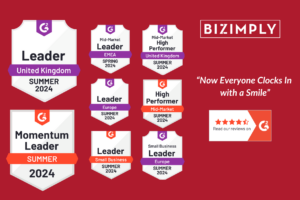Marketing health checks are similar to normal health checks because they’re easy to neglect. Nothing is visibly wrong right now, but they can shed light on problems that you haven’t encountered or maybe even considered before. Finding those small issues in your marketing practices now will help ensure they won’t get worse later.
If you are responsible for your marketing, these are the marketing health checks that will help keep your marketing practices ticking like clockwork.
At Bizimply, we believe in giving businesses the help they deserve with simple workforce management, operations and human resource management. That is why we have created this guide for businesses. It is not intended as marketing advice but a resource to better inform businesses.
Back to Basics
The basics are often overlooked in marketing health checks: if you’re lucky, the basics become part of your business’ marketing muscle memory. In other cases, they’re forgotten about altogether. Your first task on the checklist is to diagnose the problems in your current marketing practices.
- Defining your brand
One of the first things you do when creating your marketing strategy is think about how you want other people to perceive your business. The soul of your business lies in it’s ethos and values. Taking these things into consideration will help define your brand.
If you have moved away from what your brand originally stood for, you need to ask two questions: 1) Are we happy with the way we are going (and do we have the metrics to back taking this direction) and 2) Are we who we say we are?
If you are finding yourself a little unsure, a good practice is to go to the newest member of staff to ask for their fresh opinion on your business’ values, communication style and unique selling points.
- Defining your customers
When you first started defining your target market, it may have looked like something like this:
- Men 60% Women 40%
- Rugby fans
- Enjoy (your product, food or beverage).
- Favourite beverages: lager and fresh burgers
While this information is helpful, it is not detailed enough.To develop your ideal customer, you need to define them in detail. The first starting point is to pick one of your best customers who aligns with your business’ values and create a buyer persona around them.
For example, let’s say you run a chain of restaurants specialising in American style burgers and you’re looking to target your ideal customer. A buyer persona would look something like this:
Background
- Job title: Marketing Manager
- Relationship Status: Married with two children
- Age range: 25-35
- Gender Demographics: 65% Female 35% Male
- Income: €40,000 per year
Identifiers
- Loves fun and games with her kids
- Likes taking pictures in atmospheric settings and posting them on social media sites like Instagram and Facebook
Desires
- Wants to have a controlled and relaxed experience whilst creating a fun time for her family
Pain points
- Finding a place where both she and her young children can have fun and relax
- Finding a meal that is both time and cost-effective

Defining your marketing channels
Once you have completed the first exercise on your marketing health checklist, you need to now decide on how you’re going to communicate with your target market to let them know about your product or service.
Do they spend the most time scrolling through the content on Instagram (and if so, what type of content) or are they more likely to be reading the newspaper or listening to their local radio station?
Using traditional media e.g. billboards, leaflets with discounts, and radio ads can prove quite costly. If your customer reads the newspaper more than they hang out online, the obvious option is to place an advertisement in the publication they read the most.
However, more people are online. Instagram, which is owned by the social media giant Facebook, has 1 billion active users at any one time. Using your buyer persona, can help you specifically target your ideal customers.
- KPI’s
Finally, look at your current return on investment (ROI) of your marketing budget. Unfortunately, there are some things you will not be able to account for in your marketing activities, and that’s okay. Sometimes you may not know where your leads come from. Speak to your customers about how they found themselves buying from you. Anecdotal evidence, even though it may not be consistent, is still an essential part of your research into your ROI.
If you are using social media to acquire new customers, most tools collect engagement and demographics data. However, if you’re looking to take your marketing to the next level; investing in a social media planner like Hubspot or Hootsuite can help you keep track of your current marketing wins and losses.
Strategy
“An hour of planning can save you ten hours of doing.” – Dale Carnegie.
Your marketing health check is now starting to take some shape: it is time to make it move.
- What is your business’ mission?
If you already have your mission or goals, now is the time to revise them. Have you currently grown out of your current goals and is it’s time to set new ones? Or, due to the current economic climate (whether it’s positive or negative), do you have to reframe your goals?
Make sure to note the amount of progress your marketing has made since the last time your goals were set and adjust them accordingly. Where there will be winners in your marketing efforts, there will also be losers. Your marketing losses are just as important as your marketing wins, so make sure to take a note of what did not work, and grow from it.
- What are our competitors doing?
Knowing what your competitors are doing to entice your customers into their businesses is where you will pick up a lot of your key learnings. Studying your competitors will also show you where there are gaps in their service or their marketing that you can take advantage of. It also allows you to see how they are marketing to customers, what works well and how you can do the same.
- Storytelling
In our last blog, Effective Communications, we provided tips on how managers can resonate more with their teams and customers. One of the main points we focused on was storytelling.
Storytelling is one of the most powerful communication tools you can use in your marketing because it evokes emotion. By addressing your customer’s pain points or desires through storytelling, you will naturally build rapport with them. You can do this through videos, pictures and blogs.
When telling stories, you will need to evoke emotion from your audience while backing it up with logical reasons for buying from your business. You can do this through testimonials, quotes, and case studies.
Online
- Search Engine Optimisation (SEO)
By now, you’ll know the importance of optimising your website for search engines and the importance of pay-per-click (PPC) advertisements. Now your goal is to review the content on your site to see what is working, and more importantly, what is not.
While you’re focusing on your SEO, have a look at the number of pages you have. Scan through your pages and see which ones are getting the most significant amount of attention and delete the unnecessary baggage. You’ll speed up your website, which means Google will improve your user-experience (UX) ranking, thus lifting your website through Google’s search engine catalogue.
Top tip: Hit two birds with the one stone by marrying your SEO and content strategies together.
- Review your traffic
If you have not reviewed your website traffic over the last year, start by looking at the previous three-to-six months. Look at your traffic sources from Google Analytics, Facebook, Instagram and more.
Once you have reviewed your traffic, set your company a reasonable traffic target to achieve for the next three-to-six months. Growing your traffic is a timely process, so be realistic and patient with when you do set your company a goal.
- Nurture your audience
Once you have captured your audience’s tags using cookies on your website, you can re-market to them on social. Be sure to split test your advertisements online when you are taking this route.
If your audience has allowed you to use their email for marketing purposes, keep in touch with e-marketing campaigns. Newsletters are great for communicating current offers and deals with your existing prospect base.
Diagnosis and Prescription
Now that you have completed your marketing health checks you’re ready to treat your current marketing practices.
What takes an hour to do now may save you ten hours of work later, so make sure to take your time to go through each part of the marketing health checks process in our brief guide. It means your newest marketing campaigns will look and feel fresh.
At Bizimply, we believe in helping businesses grow in a time-efficient and painless manner. If you are looking to get more general guides and insights, be sure to sign up to our bi-weekly newsletter.













